New Tree: Introducing Japanese Black Pine [Bonsai]
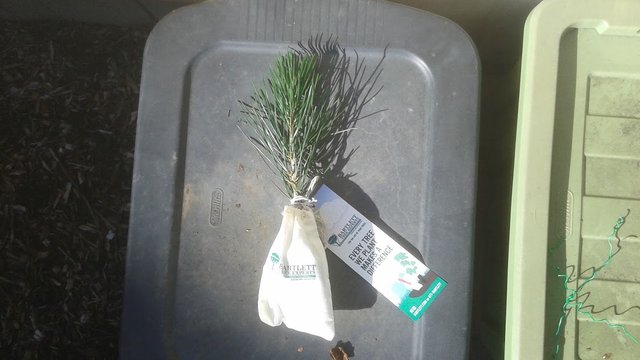
Hurray! It's almost Spring, and today I am starting to unbury my collection of outdoor bonsai trees. Today I wanted to share my newest addition to the collection, a Japanese Black Pine.
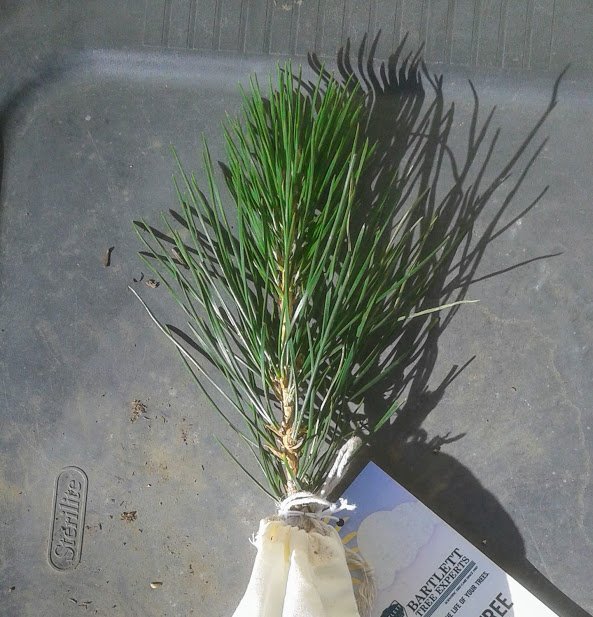
Late Winter is an excellent time of the year to buy and plant young trees if you have any interest in getting started with bonsai. Trees at this time of year are still dormant, and as soon as the temperatures warm up and the sun starts shining, the trees will soon wake up by exposing their buds with fresh new leaves and luscious green growth.
Because I like to share as many photos as possible, from beginning to end, as I practice my techniques, feel free to skip ahead using the headings below as a table of contents.
Introducing Japanese Black Pine, by @creativetruth
- Introduction
- Key Characteristics
- Examining the Roots
- Potting the Tree
- Initial Training for Style
- Future Questions to Study
- Conclusion
Introduction
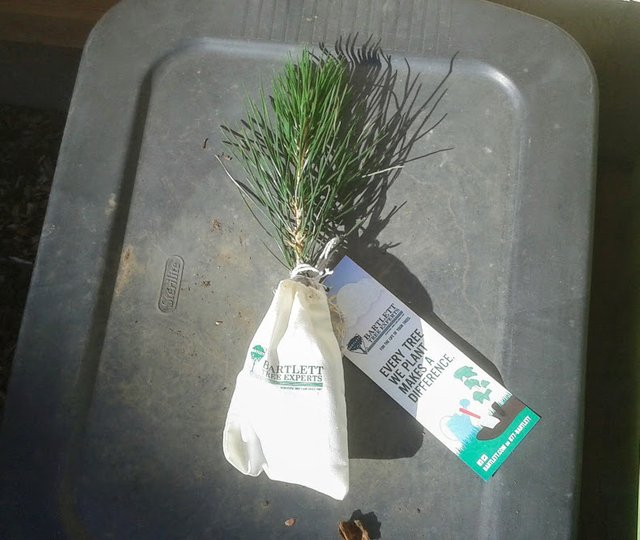
Very little do I know about Japanese Black Pine. This will be the first pine tree I have owned. Average home owners, where I live, allow pine trees to become a thick bushy mess. They will hack at them with malice using hedge shears when such a tree creeps out too far over driveways and walkways. Eventually it acts as a fence of spiny tentacles to screen out their pesky neighbors or deter burglars from entering through windows.
Along the highways, and in the dry Eastern parts of the state, I find many pine trees in their natural windswept form.
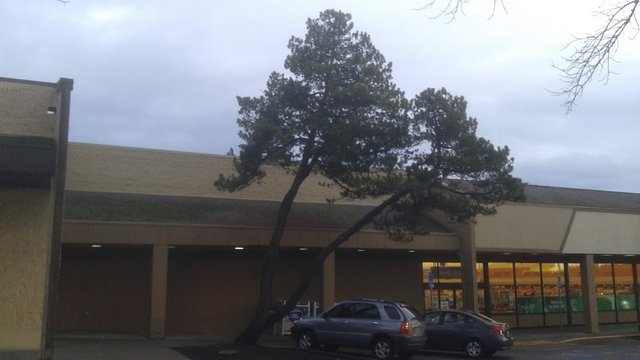
Unknown pine, growing in a parking lot. This tree has developed into a pleasing form, requiring no further maintenance. Older branches reach for light by forming separated pads of buds and needles, together making an airy silhouette of cones and domes.
Large branches are often bare with smaller branches clustering together around the tips of large branches, forming pads of upward curling needles. Anything hidden in shadows weakens until it is swept away by the winter winds. I think this is why pines form their distinctive padded branch shapes.
Near the salty seashores and sand dunes where the soil is rocky, the pine trees are the only trees that can survive the dry spells. In the arid sands, they grow vigorously after the rain, gobbling up the needed water and fertilizer nutrients.
Here are the details on this tree, which I keep track of for record-keeping purposes to ensure this tree will have an well-planned future.
Historical Details
ID: 0028
Nickname: Cheetara
Type: Japanese Black Pine
Age: 1 year (estimated)
Grown: seed (gift from nursery stock)
Last repotting: March 2, 2019
Wired: March 2, 2019

Key Characteristics
Japanese Black Pine (Pinus thunbergii) grows needles in pairs. Each pair of needles develops a papery cuticle sheath around the base, where they connect to the branch. Pairs of needles form in a circular spiral around the all sides of the branch, and the needles tend to angle towards the tip of the branch end.
Initially needles are softer tipped and fragile. Near the end of the growing season, the new needles will toughen up and develop a painfully sharp point. Needles on the Japanese Black Pine are extremely long, at 7 to 12 cm in length. With advanced bonsai techniques, full-grown needles can be drastically reduced in length, making them fit the proportions of the small tree size.
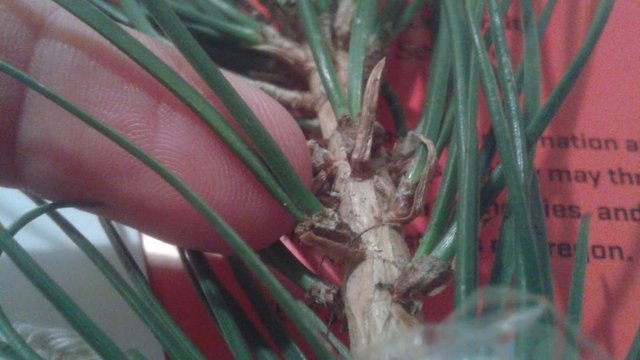
Gardeners will appreciate the deep forest green needles, with almost a hint of navy blue. It will contrast well against a wooden fence or light colored house.
Young Black Pines have a silvery grey wood tone. As the pine matures, bark will form in thick plates that is almost deep black.
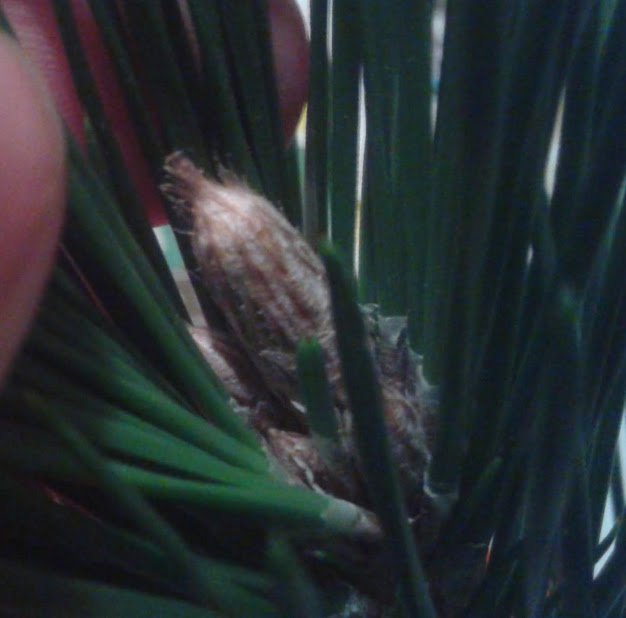
Over the winter, the tree will store up energy to build new buds. Buds can form on the branch tips, and also along parts of the older branch wood, as long as it is receiving lots of full sunlight. Usually the tops of the tree will form the most active buds. Buds can form solo, or in clusters, with usually one central bud showing as the strongest.
In Spring, the buds will elongate into long spires, called candles. Candles will become new wood, which will harden into branches next year. New needles will appear in Summer on the candles. Needles will never form on old wood without a bud.
Knowing which needles to remove, and how to prune the candles and branches takes a lot of experience and learning. A true bonsai master will prune a tree based on its age, species, health, design, and experience in knowing how to restore balance to the tree. A perfectly balanced pine develops candles of equal size from every bud. This is a sign that all branches are healthy and receiving equal proportions of growth energy.
A masterfully maintained bonsai pine will have a beautiful tapered curving trunk, and branches supporting pads of small needles.
Examining the Roots
A lot can be learned by looking at the roots of the tree. One thing I first noticed is how clean the plastic bag on the roots seemed to be. It must have been bagged up only days before it was shipped out. I received this tree as a free gift for attending the Plant Nerd Night in my hometown of Lake Oswego, Oregon. To keep the tree cold overnight until I was ready to plant it, I let it lay against the chilly glass window in my bedroom.
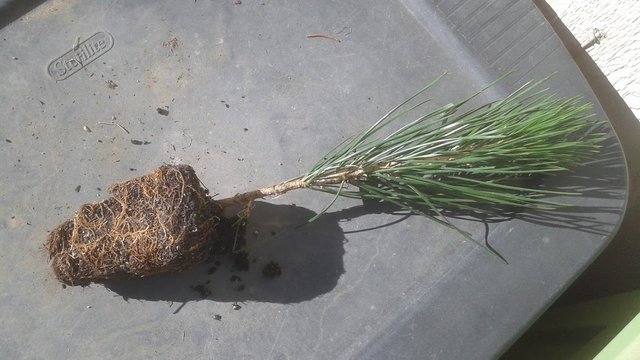
These roots look very healthy and clean. All gold roots, no black. I am very glad this tree has some soil included with it, because this type of tree requires a specific type of matching #mycorrhizae in the soil in order for the tree roots to take up nutrients. Without the native soil included for the fungus to spread, this tree would eventually die early from starvation.
The soil is very soft, wet, and crumbly, like typical potting soil. I can see some fertilizer beads nestled within the roots. This tree has been germinated from seed and maintained by a professional tree conservation company, so I can feel confident knowing that this tree has been properly fertilized, and is ready to start growing vigorously.
Some roots are starting to spiral around the corners, which means the tree is looking for more space to reach its roots out. There is no central taproot that I can find, and that is also a very good sign. With roots flaring out in all directions away from the trunk, this is the ideal root shape to support the tree.
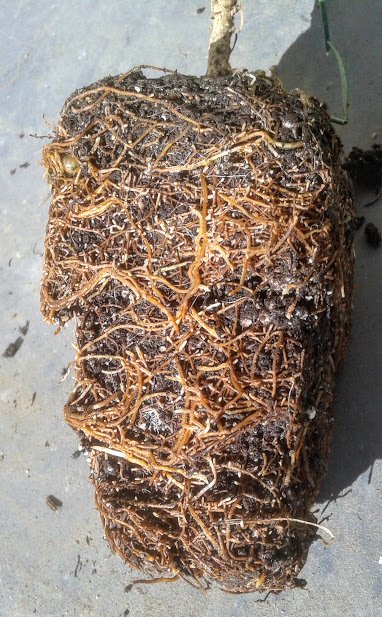
Although I am tempted to trim away the roots cornering around the edges, I know that a lot of the energy is stored in those healthy roots, and I do not want to stunt this tree's growth early on, or infect it with disease, or kill it. Those corner roots are also helping to hold the soil together in one piece, which is very fragile and already falling apart. For that reason, I am choosing to keep the entire rootball and soil fully in-tact as I prepare the tree for potting.
Potting the Tree
First things first. I browsed my collection of rinky dink pots to see what I can find. Some have cracks, and will not support a tree for any length of time.
Normally a terra-cotta or earthen clay pot is used for pines. I believe this is because it wicks away moisture from the edges, and keeps the roots cool in the summer. I have a few glazed pots, but I'm going to hang onto bonsai wisdom I've been taught, and avoid using them with pines.
Apparently glazed pots will screw up the Feng Shui associated with conifers, and I don't want to anger the ancient Chinese Geomancers.
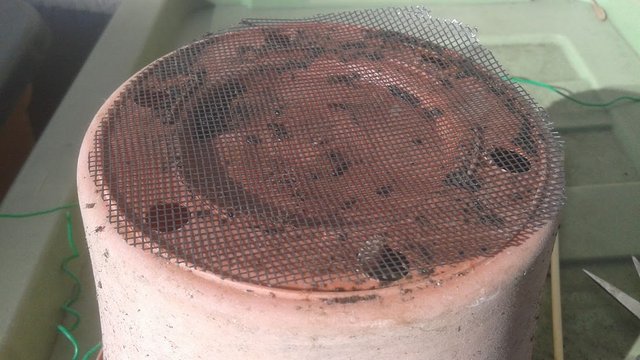
This pink pot is plastic and slightly resembles the terra-cotta pots in color, and I think it makes a good color contrast with the needles too.
Traditional aesthetics in bonsai demand that the tree should draw more attention than the pot, although both are essential. This is why bonsai pots are often supremely simple, rustic, and not overly ornate, even though they can be ridiculously expensive to purchase well-made pots. A Korean-made pot on display in a museum, though small, brown, plain, and simple, might be a priceless artifact.
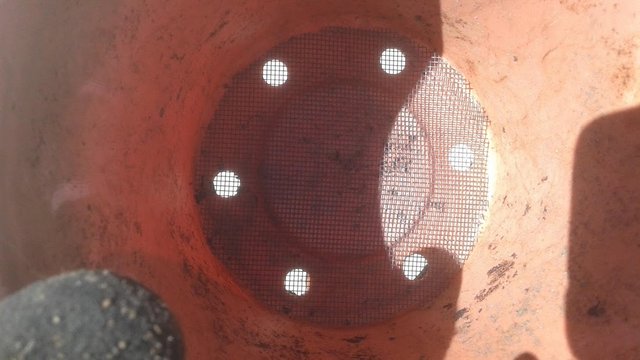
Screen material used for screen doors is what I choose to use to cover the holes in the pot. It is very easy to fit the screen around the opposite side of the base, and simply cut around it with scissors so it fits inside. Don't use your best scissors though, because the metal inside the screen will dull the blades. Wear gloves while doing this, because the screen edges will be sharp.
Be sure the pot has large holes to allow lots of even drainage at the base. Some of the holes look obstructed slightly when I lift it into the light. On the back side I noticed the plastic perforated circles had not been completely removed from the attached edge of the holes. With some scissors, I cut off these pieces to allow the holes to be completely open.
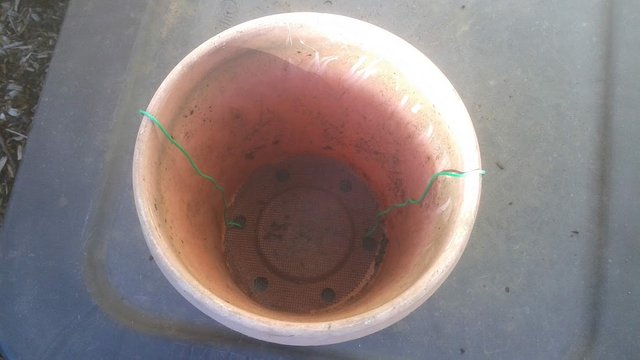
I string a wire through the underside of the pot, and curl them over the edges on the inside. These wires will be used to hold the tree firmly into the soil, so it doesn't move, tip over, or become dislodged. Trees love to feel stable, and that is why they form thick roots under the soil surface around the trunk.
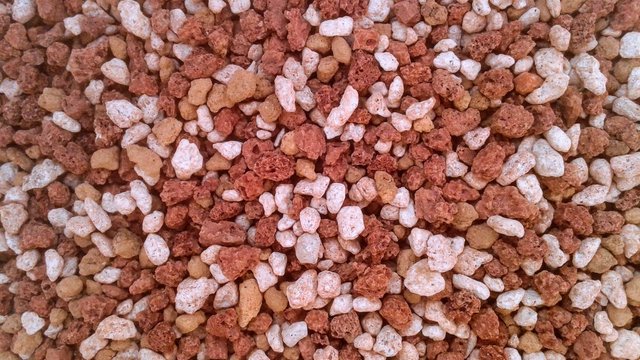
This is the end of my supply of primo bonsai soil mix. It has various forms of porous pumice rock, such as lava rock and white pumice. Pumice is called red lava rock when it contains high amounts of iron, but it has the same shape properties as regular pumice. The brown akadama is a volcanic clay, imported from Japan.
There are rumors of an akadama equivalent to exist, quarried from the volcanic bowels of Mt. Hood nearby. I am not sure, but I think there is an entrepreneur who is sitting on it, hoping to make a small fortune in sales. If anyone learns of a local inexpensive bonsai clay dealer, let me know.
Online purchases can be spendy due to the volume and weight of imported akadama, and there is no way to ensure the clay isn't shook up and pulverized into dust until after the mystery package arrives in the mail.
I know some people use turface and kitty litter clay, but I don't want to put that nasty stuff into my bonsai soil. I understand it breaks up too easily into a mess. Usually that stuff is designed to dry up moisture on fields, or remove odor. Bonsai akadama clay is unique because it is has extremely small porous tube-like structures, and it is slightly hardened by the heat from volcanic activity.
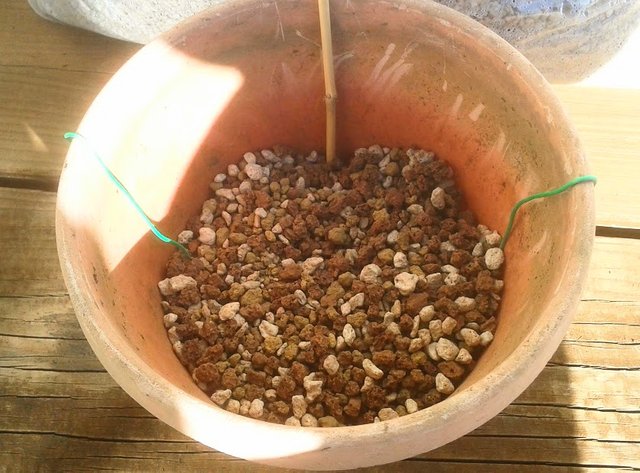
Filling the base of my pot with half of my remaining bonsai mix, this will ensure that the bottom roots get access to the nutrients stored in the clay and ideal levels of moisture and air.
With an old bamboo stick, I nestle it in near the side. I plan to use the bamboo to help me to stake the trunk into place vertically.
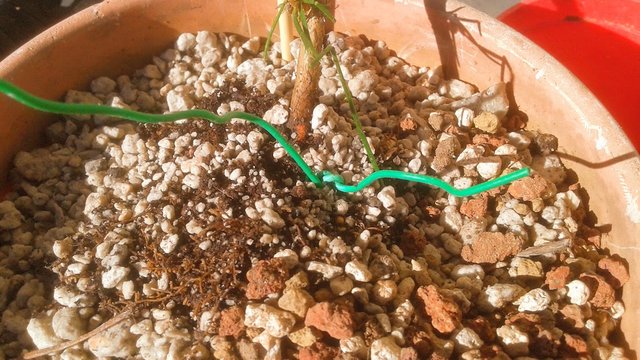
Placing the tree at a steep angle, I bury the sides of the roots with white pumice, and cover with a top layer of the remaining bonsai soil mix. Using the wire, I was able to wrap around the top of the rootball, to secure it against the surrounding soil. If the soil settles over time, I can go back in with some pliers to tighten up the grip of the wire against the roots.
For pine, I chose not to add any form of organic soil. Completely inorganic (rock) soil is recommended by fellow bonsai growers living in my area. The rain itself drops lots of organic material that will form into sludgy clay, algae, and moss. These things have to be cleaned out every few years when re-potting the trees, to increase drainage. Pines like to have their roots dry out in the soil slightly, as it helps spur the tree into a healthier growth cycle.
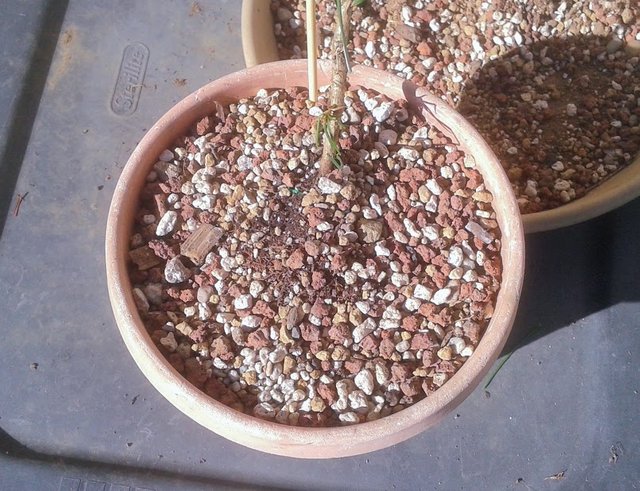
Hard to see, but there is a small bud forming and inch above the soil line. I positioned the tree at an angle so this bud will face upward and receive more sunlight.
Then I tucked the wires down into the soil, and roughed out some of the soil and top roots, to blend it in a bit. I was trying to find the true base of the tree, were trunk begins, and roots actually start to form. This location is where the height of the soil line should be.
Now that the tree is happy in its new home, it's time to take a step back and see what we have so far. Almost done!
Initial Training for Style
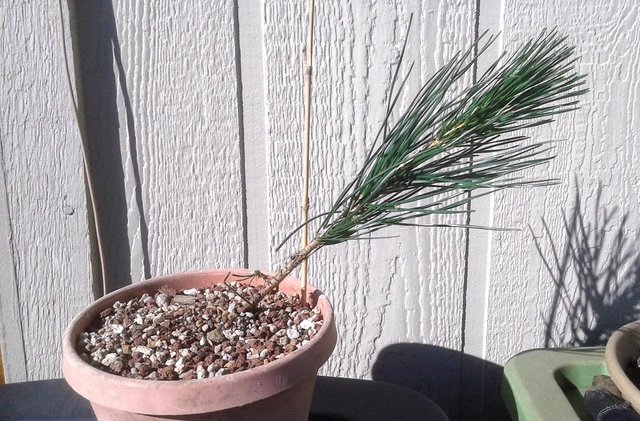
A slanting style tree might be an attractive form for this tree. A common development for such a tree is to ladder the branches out horizontally along the slanted trunk, to form pads of needles alternating on either side. Largest branches near the bottom, and smaller ones upward along the trunk, ending with a small crown of tightly packed buds and small branches.
Using the bamboo stick, I secure some wire slightly loose around the trunk, to help maintain this vertical position at this junction of the tree.
In past years, I have almost always allowed my trees to grow upright, and allow the buds to form the style of the tree. This time, I am feeling the need to try something more dramatic in my approach. This young pine has an extremely flexible trunk. It feels like rope. Will the tree be this flexible next year? Probably never again in its life will the trunk be so flexible. I am going to form a sharp bend in the trunk, to balance the tree back over the center of the pot. A side-heavy tree could easily tip over and fall out. Even worse, the pot might tip over, spill the soil, and the roots would be exposed. Treeicide!
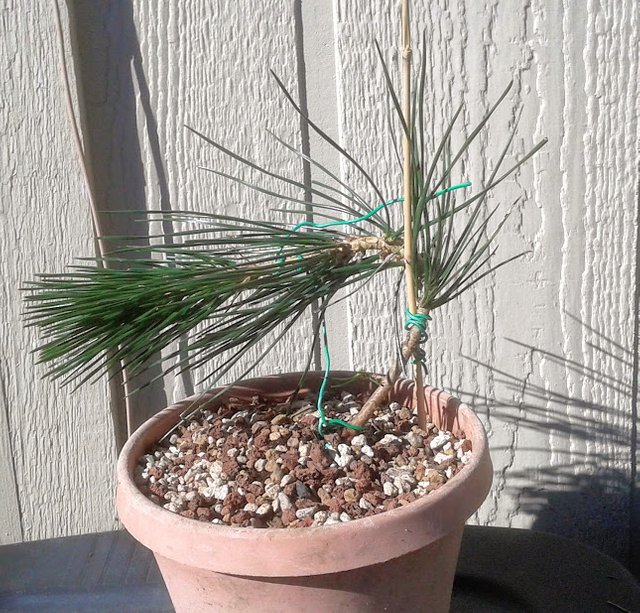
Here we are!
Using another wire, I used a technique I have observed in a Niwaki (Japanese Small Garden Tree) pruning book. The wire pulls the top of the tree downward, and I secured it onto a lower, sturdy part of the tree. This forces the angle to be maintained, and allows the natural flexibility of the trunk to distribute the stressed angle more evenly along the entire length. Too much bend exerted on a single point can cause the trunk to weaken, split, and crack. Bonsai bondage torture technique! Do not attempt! A practiced master knows how much bend their tree can endure.
The alternative method is to spiral wire around the trunk, but this is problematic for pine, as it would require removal of all the supporting needles. Wiring a spiral around the trunk also causes wire groove marks to form on the entire length visible trunk of the tree, which I do not prefer.
My guide wire was slipping up the neck of the tree, so I curled the end and hooked it in under the soil, to attach it to the wires holding the roots down. If this comes loose, I can always come back and use pliers to twist the wire so it grips more tightly.
Remember the nickname I chose for this tree? Cheetara was a memorable cartoon character in the 80's TV series, Thundercats. Cheetara was a badass! She was a hybrid Cheetah person with tons of super powers: she could run so fast and agile that lasers trailed her path, she had psychic premonitions of things happening far away, and she also had an extendable staff that can become pole-vault rod. Cheetara rocked every episode in an orange leotard that made Farrah Fawcett jealous.
Cheetara reeked femininity and sex-appeal to the core, but never thought of herself as better than anyone else. She was treated like an equal, but she often proved she was the best! Her undeniable usefulness, leadership qualities, wisdom, loyalty, and unwavering obedience to Lion-O, Lord of the Thundercats, made her an integral core member within the Thundercats family.
Thundercats were animated by Japanese artists, and American audiences have always loved its exotic action scenes, realistic character portraits, and the compelling story-line. And who can ever forget the opening pop rock anthem theme song?
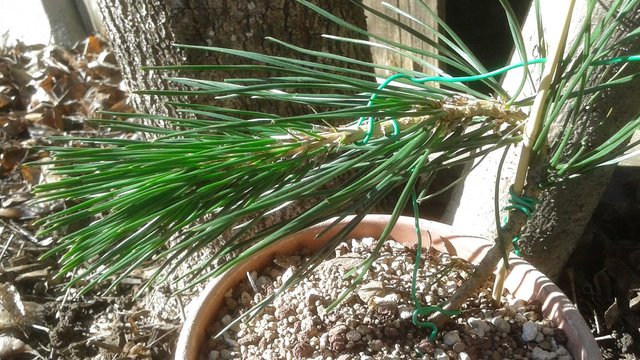
The lightning bolt shape of this tree has some of the Thundercats vibe happening already. The needles are sharp like cat claws. The colors jump out like an animation. The candles extend quickly, much like Cheetara's staff. Like Cheetahs, this tree can thrive on the sandy savannas. It grows faster than most other trees, leaving the others in its wave of dust.
Future Questions to Study
There is so much for me to learn about growing pines for bonsai, I barely know where to begin. Pines all require different pruning methods, and they are worked on at different times of the year.
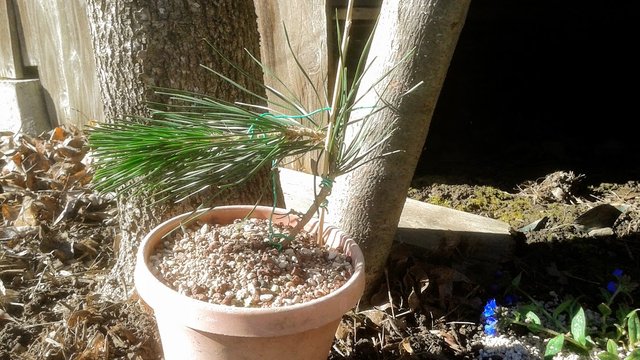
My Japanese Black Pine photographed in a natural woodland setting beside blue flowers (Pumonaria 'Benediction', Lungwort).
Things I'll have to consider as this tree develops:
- When should I pinch needles?
- When should I prune candles?
- How do I know which candles should I prune?
- How much of the candles should I prune?
- How do I fertilize this tree? When? How often? With what?
- When should I repot this tree?
- How should I best develop the shape of this tree?
- Which branch directions should I aim for? Future style?
- What kind of pot will this tree require? Why?
- How will this tree fare on hot and cold days?
- How should I best protect this tree to survive potted in my climate?
Conclusion
Part of the joy of the way I approach my bonsai hobby is to learn through experimentation, reading, experience, and asking questions of fellow enthusiasts and masters. Freedom to do things my own way is what really makes the art of bonsai an enjoyable way for me to spend my time with my trees. Bonsai trees have a way of drawing the eye, to make onlookers sit and gaze at them, or sometimes even pray and meditate beside them to find peace, harmony, and direction. Trees are happy to become a new friend or companion to any lonely traveler in need of rest.
Often times my trees teach me more about growing them than I could ever learn from anywhere else. Trees do speak many words of wisdom to me, but they have no mouths capable of making sound. They have no psychic abilities to tap into our minds like Bran and Bloodraven (A Game of Thrones).
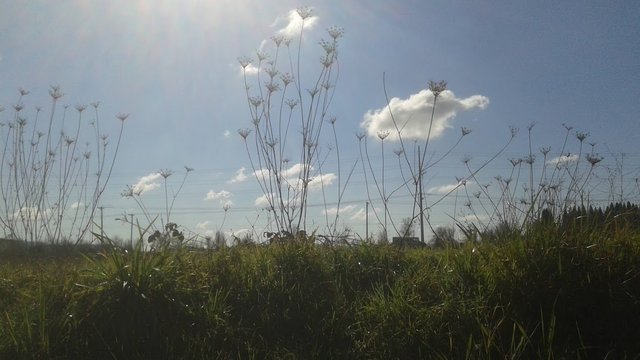
If a tree falls in the forest, and there's nobody around to hear, does it make a sound?
It is quite silly for existentialists to repeat the human-centric question about the tree falling in the woods, that makes no sound. There is barely a speck of space on this planet in which the natural world is not hosting life: bacteria, plants, insects, animals, and people. I believe trees are bound deeply into the lives of all things, being a necessary background force within our various ecosystems. When a tree falls, it is always heard by someone. Will they listen to its message is the real question, to me. A better question might be...
When the last tree falls, will anybody still be around to hear it?
-@creativetruth
Calling out my fellow bonsai enthusiasts, #teambonsai, #bonsaicommunity, and #TeamHorticulture for comments and feedback. Your words are gold.
@daniellozada, @imagendevoz, @romanolsamuels, @bonsaiaustin, @synekto, @shadowolfdg, @mrbloom, @willymac, @mattlovell
Photos in this post are all #originalworks by @creativetruth, unless stated otherwise.
Find me on discord and chat with other tree growers, bonsai enthusiasts, and gardeners. We have quite a few accredited experts filling out our ranks, and a helpful Spanish-speaking community.
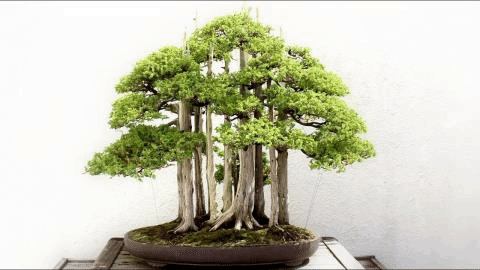
Bonsai!

| Account Value: $828.12 | Votes Given / Received: 5,205 / 16,493 |
| SP: 2,091.157 | Posts / Comments: 296 / 2,397 |
| STEEM / SBD: 1.808 / $0.002 | Delegated In / Out: 0 / 280 |
| REP: 63.658 | Followers: 1,686 / 213 following |
| Curation Rewards: 1.863 SP | Author Rewards SP / S / SBD: 33.463 / 0 / 0.022 |

| STEEM In / Ex = 0.396 / 0.38148 | BTC / ETH/ LTC = 3799 / 131.3 / 47.3 |
| SBD = 0.97091 | Gold/Silver oz. = 1,294.45 / 15.27 |
#JPN #japanese-blackpine #black-pine #conifer #evergreen #green-needles #needles #tree-pruning #pruning #bonsai-care #hobby #gardening #small-trees #shrubs #niwaki #art #creative #how-to #diy #instruction #teaching #learning #inspiration #hobby #bonsai-hobby #soil #bonsai-soil #Pinus-thunbergii #Cheetara #thundercats #femininity #female-heroes

Considering my failure to even keep these alive in my part of the world, my advice would be useless. But, I do wish you a lot of luck with this tree. I'm sure it will be amazing one day. I found this article which I believe would be the most useful to you: https://www.bonsaiempire.com/tree-species/pines
Thanks for chiming in. It could be an epic failure for me too. We'll see!
Thanks for using the artzone tag @creativetruth, otherwise I would’ve missed this one—this is a very informative article. Great job!
@splatz. You got time for two in one day?
I always got time for you buddy. Hey hey hey Splatz away!!
source
Rewarding Your Original Work
With an Upvote
And
Resteem
If you find posts worthy of a nasty Splatin’ feel free and mention @splatz in your reply to their post. Call me out!!
A pleasure being splattered. Do you prefer to curate certain categories/causes, or all-around any quality posts?
Anything that shows some effort and originality. I am pretty flexible but those 1 photo and 2-3 sentence posts go no where around here. I see posts like that getting $20 and then I see people putting in hours towards a post and they get pennies. Those are the people I am attempting to help and give a little more exposure to.
Thank you
I hope that your Bonsai would get beautifully done in the future I admire your dedication to your craft @creativetruth
I love Thundercats, I remember that they raced but Lion-O won.
That was one of the best story arcs, when Lion-O had to beat all of the other Thundercats, to prove he deserved to lead. Justice, Truth, Honor, and Loyalty. The code of Thundera always felt right to me.
This article is featured in The Thursday Shift—a weekly ArtzOne curation—thanks for representing #artzone!
Thank you so much.
Excellent publication, you have a great knowledge in this area, a high quality and very informative publication, I congratulate you today, new learning, I am also in the art group, if you want to visit me and see my publication, it would be wonderful to support us all in this way our publications will have more projection in the community, greetings.
https://steemit.com/music/@artzone/artzone-curation-the-thursday-shift
Sure. I'll check out your works. Thanks for viewing and the kind comment.